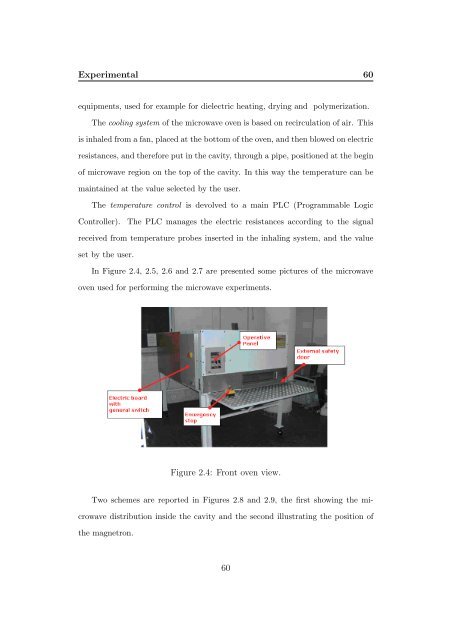Kinetic Analysis and Characterization of Epoxy Resins ... - FedOA
Kinetic Analysis and Characterization of Epoxy Resins ... - FedOA
Kinetic Analysis and Characterization of Epoxy Resins ... - FedOA
You also want an ePaper? Increase the reach of your titles
YUMPU automatically turns print PDFs into web optimized ePapers that Google loves.
Experimental 60<br />
equipments, used for example for dielectric heating, drying <strong>and</strong> polymerization.<br />
The cooling system <strong>of</strong> the microwave oven is based on recirculation <strong>of</strong> air. This<br />
is inhaled from a fan, placed at the bottom <strong>of</strong> the oven, <strong>and</strong> then blowed on electric<br />
resistances, <strong>and</strong> therefore put in the cavity, through a pipe, positioned at the begin<br />
<strong>of</strong> microwave region on the top <strong>of</strong> the cavity. In this way the temperature can be<br />
maintained at the value selected by the user.<br />
The temperature control is devolved to a main PLC (Programmable Logic<br />
Controller).<br />
The PLC manages the electric resistances according to the signal<br />
received from temperature probes inserted in the inhaling system, <strong>and</strong> the value<br />
set by the user.<br />
In Figure 2.4, 2.5, 2.6 <strong>and</strong> 2.7 are presented some pictures <strong>of</strong> the microwave<br />
oven used for performing the microwave experiments.<br />
Figure 2.4: Front oven view.<br />
Two schemes are reported in Figures 2.8 <strong>and</strong> 2.9, the first showing the microwave<br />
distribution inside the cavity <strong>and</strong> the second illustrating the position <strong>of</strong><br />
the magnetron.<br />
60
















